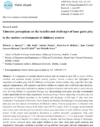Abstract
It is important to consider physical activity and movement in early life to ensure children establish and maintain healthy physical activity patterns. Recent evidence has highlighted the importance of outdoor play and the childcare environment. Active outdoor play, especially free play, supports independence, self-regulation and allows children to explore their world and make decisions. Loose parts or open-ended materials are natural or synthetic resources that can be used in more than one way, allowing children to experiment through play. Incorporating loose parts into play environments creates opportunity for new play experiences. Despite growing evidence supporting loose parts play, the perspectives of childcare providers on the benefits and challenges of this type of play have been overlooked. The purpose of this study was to identify the benefits and challenges of incorporating loose parts play into the outdoor environments of childcare centres, from the perspectives of educators who took part in the Physical Literacy in the Early Years (PLEY) project. PLEY is a larger, mixed methods intervention study with the goal of evaluating a loose parts intervention in early childcare settings. This portion of the project used qualitative description to explore educators’ perspectives. Data were collected using focus groups (n = 15) with early childhood educators (n = 3–5 in each group). Thematic analysis was used to identify five themes relating to benefits, and four themes relating to challenges. Benefit themes included: loose parts enable children to take risks; loose parts spark creativity and imagination; loose parts contribute to problem-solving abilities; loose parts cultivate independence and confidence; and loose parts build relationships and leadership. Challenges included: apprehension of loose parts; loose parts as a novelty; sustainability of loose parts; and loose parts present challenges with storage. Overall, we found educators perceived outdoor loose parts play to have multiple social and cognitive benefits for preschool-aged children that are critical for optimal growth and development, and overall health and wellness.



Responses